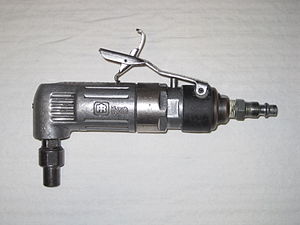This article is written like a personal reflection, personal essay, or argumentative essay that states a Wikipedia editor's personal feelings or presents an original argument about a topic. (February 2020) |


A die grinder or rotary tool is a handheld power tool and multitool used for grinding, sanding, honing, polishing, or machining material (typically metal, but also plastic or wood). All such tools are conceptually similar, with no bright dividing line between die grinders and rotary tools, although the die grinder name tends to be used for pneumatically driven heavy-duty versions whereas the rotary tool name tends to be used for electric lighter-duty versions. Flexible shaft drive versions also exist.
The die grinder name comes from one of their earliest and archetypal applications, tool and die work, where they were used to create the precise contours of dies or molds. Especially before the advent of widespread CNC usage, they were heavily relied upon for contouring via manual skill comparable to a sculptor's. CNC now provides much of the contouring for die and mold interior surfaces, but die grinders are still very useful for hundreds of cutting needs, from sculpture-like contouring in the absence of CNC, to cut-off of bar stock, to any of the cutting and grinding needs of fabrication, such as in the work of welders, boilermakers, millwrights, ironworkers (steel erectors), sheet metal workers (such as auto body workers and HVAC technicians), to woodworking (especially cabinet making), hacking, and other hobby or business pursuits. Die grinders are often used for engraving, cylinder head porting, and general shaping of a part.[1]
Die grinders typically rotate at a high speed, typically 25,000 rpm. This is much faster than most cutting tools. As such, one must use accessories rated for such a high rpm to avoid the tool shattering.
- ^ Benford, Tom (2006), Garage and Workshop Gear Guide, MotorBooks/MBI Publishing, p. 87, ISBN 978-0-7603-2312-0.